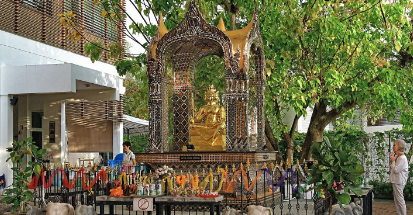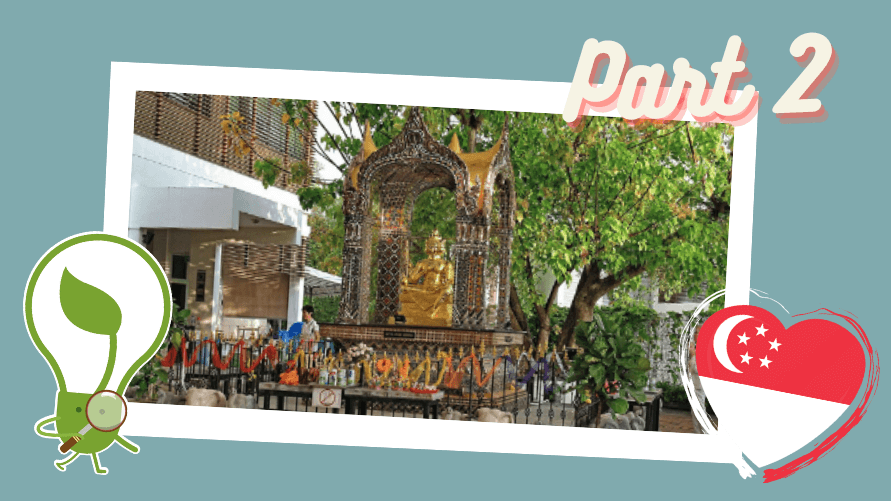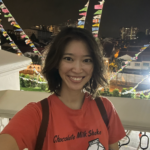Editor’s note: Special thanks to Jom, an independent journal website that has allowed us to republish this article. The original piece can be found here. This article has been further edited to follow HOL’s standards. This is a two-part article series on Marissa’s journey through the Buddhist scene in Singapore. Read part I here.
TLDR: Marissa explores Bedok & the mettaverse hidden gems where peace is often hidden amongst these bustling areas of Singapore.
3. Simpang Bedok
Having been raised Catholic, I was surprised to learn that Buddhists are not required to visit temples for worship. If however, a visit is paid, intention and clarity of purpose is more important than blind piety.
In both the Mahāyāna and Theravāda traditions, dāna (generosity in Pali) is the first in the list of pāramī (perfections) that beginners are taught to cultivate. You can’t learn to meditate without first learning how to let go. And how can you let go if you don’t learn how to give? This was the premise for my first visit to Palelai, a Theravāda temple on top of a hill in Simpang Bedok. I offered Yakult to the monks and made a mental note to arrive earlier next time, to give my mind time to really settle into the giving, instead of worrying about being late.
Afterwards, I stood in the shade of a bodhi tree as my friend, Kweh Soon Han, told me the story behind the four-faced brahmā statue that gleamed golden in the sun. Brahmās, I learnt, dwell in a subtle realm hidden from the sensual plane.
Some call them gods. The four faces reflect the fact that a brahmā’s mind knows only four sublime states: loving-kindness, compassion, sympathetic joy and equanimity. Brahmās are incapable of evil.

The most famous brahmā is Sahampati, who in a past life was friends with the man who would become Buddha, when they were both training as monks. After this man got enlightened, he very nearly stayed a silent Buddha, for he perceived that the path was too difficult to teach.
Luckily, Sahampati knew the Buddha’s mind. On bended knee, he invited Buddha to teach the Dhamma, out of compassion. “So,” Mr Kweh finished, “you can say, ‘Thank god for Buddhism.’”
Mr Kweh often worried about Buddhism losing ground with younger Singaporeans, so he took care to be my guide. Indeed, Buddhism in Singapore is so entwined with folkways and superstition that its essence is easily hidden from view. The nontheistic Buddhist worldview syncretised famously well with other Asian religions, so confusion may also arise when images of Guan Yin—the bodhisattva of Chinese Buddhist cosmology who hears the cries of the world (“观世音”)—are spotted alongside those of Confucius and Taoist deities in Taoist temples and shrines.
Finally, it doesn’t help that those Buddhists who have had a glimpse of nirvana tend to be low-key, preferring solitude.
I used to attend a Friday night meditation class at Palelai where I was one of just three students. But we spoke freely with Bhante Varañāṇo, a teacher who answered all our questions skilfully, and it felt like everyone was there for the right reasons. The challenge for many temples here is how to create an environment conducive to meditators in a place like Singapore, where the grating details of urban living are always just round the corner.
During a recent retreat at Palelai, an elderly monk was leading us in qigong outdoors. Perhaps 80 of us, young and old, were hanging loose and opening our meridians when a mechanical hum closed in and thick chemical clouds descended from the narrow drain that separates the Palelai garden from the houses above. We were all fogged, together with the mosquitoes.
On the whole though, Singapore is not a bad place to practise.
When many are gathered with the right intentions, the quality of light that defines Palelai can swell into something quite palpable. Like on nights when public talks are held in the semi-outdoors, and everyone sits silently in rows on the long reed mats, listening. Really. Listening.
4. Into the Mettāverse
I used to tell people that I started meditating as a way to deal with the pandemic’s restrictions: “You can’t travel outward, but you can travel inward.”
Now, post pandemic, I’ve come to enjoy spending entire weekends at home, just sitting and reading, toggling between interoception and introspection.
I’m not a skilful meditator, so I get stuck in my practice every now and then. When that happens, I try to use the flavours of different emotions to compose or energise my mind as I go along. Sadness is particularly useful. When you are desperately sad, the urge to be emptied of yourself should arise like a reflex. Misery is more humbling than joy in this way. But once the doors of perception have been opened a crack, it is laughter and gratitude that have the power to change your mind.
At least, that’s what I experienced. I was sitting alone one day when my mind drifted to a funny moment from earlier that morning.
I laughed at the memory and felt gratefulness welling up in me, and tears. I reflected on the joy of having friends who are so dear, and I could feel my heart fill up like a special kind of vase, brimming with contentment that seemed to come with a knowing that if I let it spill out, more would fill its place. That gave me the energy to keep sitting.
When I tell my friends about going to Buddhist meditation retreats, I sometimes get sceptical, even worried reactions. This is natural. We live in a troubled world where cynicism has become an important defence. Religion is also a sensitive subject. But meditation is not an inherently religious activity. Anything can be an object of meditation—a Bible verse, a candle flame, the breath, body sensations.
Many Buddhists like to meditate on mettā (loving-kindness). In mettā meditation, you basically focus on what goodwill feels like, and then try to direct that goodwill to everyone, unconditionally.
It is not difficult to feel goodwill towards those who are dear to you, or even to strangers—but try radiating loving-kindness to people you dislike. It’s impossible unless you learn to let go of self-absorption. One way to do this is to try and notice thoughts and habits as they arise, in order to step back from them.
So you could say that meditation, and the troubleshooting that’s required to get into deep meditations, is really a scientific inquiry. It is about knowing your mind. In Buddhist circles, this isn’t called spirituality. It’s called reality. Many people practise meditation without Buddhism—it was trending in South Asia long before Buddha was born (in the 6th century BC). But for me, Buddhist wisdom and meditation go together because my intention is to see things as they really are. And the more I sit, speak with or read about people who meditate, the more it becomes clear to me that the gross reality that our minds experience cannot be the ultimate reality.
But for now I am still puttering about on a small island, trying not to get too caught up in the names and occupations that we recognise for expediency in a language that comes from one way of seeing things. I wonder if the biggest enemy of Buddhism is not any other religion, but rather, materialism and wanton consumption, narrow-minded capricious living.
It recently occurred to me—and then only because someone mentioned the word—that I haven’t been bored in a long time. I’ve stopped using Netflix or YouTube as opiates, and I don’t need alcohol to help me scatter my aversion towards this hot, dense city.
Maybe this is what it feels like to have found a dependable worldview. It’s a thought that makes me feel glad and silly at the same time. Two years ago, I would never have guessed that the nearest thing to magic in my life—the magic of a world within a world—would unfold right here between the charmless slabs of office towers and malls.
I just had to learn how to look.


